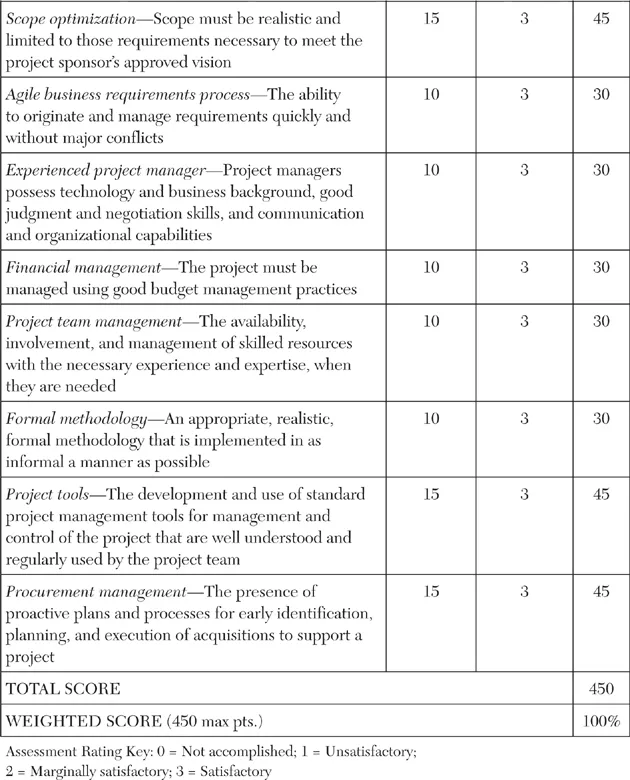![]()
Chapter
1
WHY PROJECTS SUCCEED
IT projects are notoriously risky endeavors. When confronted with the prospect of a new IT project, business owners and executives too often predict dire outcomes: “If the project delivers anything at all, it will most likely be late and over budget.”
That attitude seems a bit unfair, particularly when nearly one-third of IT projects meet their objectives, provide the full scope defined for the project, and do so on time and on budget. Even so, two out of three business owners and executives most likely share that perspective, because they sponsored the other two-thirds of the IT projects that struggled or failed.
So, what’s the difference between a successful IT project and an unsuccessful one? What makes one seem so effortless and another a frustrating mess?
The following questions and answers are intended to provide you with some of the information you will need to hit the target for your IT projects.
SUCCESS FACTORS
Q1 Why are IT projects considered so risky?
In its truest form, IT project management is about creating something where nothing existed before. Sometimes we modify an existing system in a way that has not been attempted in the past. Every time we take on a project, we develop something that, to some greater or lesser degree, did not exist before. Venturing into the unknown requires experience and professional stamina.
Have you ever stepped into a dark room? You know you must negotiate your way through a maze of furniture. There is a light switch somewhere in the room to illuminate your way, if only you could find it. The absence of that illumination promises bumped shins and more.
Sometimes taking on a new IT project feels like stepping into a dark room. If you have not walked the paths that lead to IT project success before and have no source of illumination, the future can be very hard to see.
Experienced IT project managers bring knowledge of what lurks in the darkness of that room. They have tried, failed, tried again, and succeeded. They know where many of the switches to light the way to project success can be found. Unfortunately, there are not enough experienced, trained IT project managers to go around.
The presence or absence of a qualified project manager has been identified as a key indicator of project success or failure. If there is one reason why IT projects are so risky, it is that the supply of experienced, trained IT project managers remains so low.
Anyone can hang out a shingle and call himself a project manager. In organizations where IT project management is not a core competency, management appoints project managers because of their technical skills or business acumen, or because they are the only ones available to do the job. Little attention is paid to whether the person possesses the necessary credentials or background to handle the complexities of an IT project.
So, what is the answer? What do you do when you need a project manager for a risky IT project and there isn’t one to be found?
The answer is to partner up. Sometimes that means pairing a good non-IT project manager with a good technical team leader who can supplement the project manager’s lack of IT background. At other times it means matching an IT technical resource who might be the best candidate for project manager with a solid business resource who can relate to the project team members and translate the organization’s needs into technical terms.
Q2 What are the key indicators of IT project success and failure?
Experience suggests that a handful of indicators can predict project success and can be relied upon. They include:
• User involvement—Relates to involving the right users, who will depend on the technical solution professionally and personally to meet their goals
• Executive support—Specifically related to how timely decisions are made regarding critical issues that impact the project
• Clear business objectives—The focus of the project must be on the business value that the project is to provide the organization, which is driven by a clearly articulated vision of the project’s deliverable solution
• Scope management—Delivering what the users of the new system need to do their jobs; avoiding extraneous functionality that might never be touched by the users of the system
• Business requirements management—The ability to be flexible, yet decisive, in shaping, changing, and managing project requirements
• Experienced project manager—Having a project manager on the team who has experience with projects of similar size and complexity within the industry on which the project is focused
• Financial management planning—The presence of objective tools for monitoring and interpreting a project’s financial status and relating that to project performance
• Project team management—Having access to project team members and subject matter experts with the requisite skills and knowledge to do the work necessary to provide an acceptable solution
• Use of a formal methodology—The availability of a project delivery approach that is formally identified yet executed as informally as possible
• Project management tools and infrastructure—The availability and application of tools to facilitate project success, such as schedules, collaboration tools, and scope management tools, and the ability to use and interpret the project artifacts produced by those tools
• Procurement management planning—Progressive and responsive procurement planning and execution processes that identify procurement needs and the best approach for filling those needs.
FIGURE 1.1 Project Success Assessment Matrix
The goal is to identify these success factors in advance, address them early in the planning process for any project, and develop a realistic estimation of a new IT project’s ability to succeed. For ongoing projects, periodic assessment of the success factors and how they apply to the project can offer insight regarding how the project is progressing. Course corrections can then be made, if necessary, and focused on the area of the project most in need of attention.
Q3 How is business value defined in IT projects?
In project management parlance, an objective is defined as the business value provided to the organization. IT projects with well-defined business objectives relate well to the needs and concerns of the business owners who fund them.
From a practical perspective, IT project objectives are usually stated in SMART terms:
S—Specific. The focus of the objective should be on a single business value that relates to a core business strategy of importance to the organization.
M—Measurable. The business value should be quantifiable. The value should be stated in terms of percentage of increase or decrease, dollar value, or other measure. Note that “none” and “all” are quantifiable.
A—Assignable. One or more stakeholders in the organization should be willing to sign up as the sponsor for each specific objective developed for a project. If no one is willing to sponsor an objective, there is no practical reason for the organization to see the objective as valid. That objective would be considered out of scope.
R—Realistic. An objective should be reasonably achievable, given the constraints of money, time, available technology, and resources.
T—Time-bound. The business value identified by the objective should be achievable within a reasonable, defined period of time. Vague promises that things will get better over time by using a new technology are not enough to stimulate investment in something as risky as an IT project.
The new financial management system will cost approximately $1.5 million and deliver a savings of $500,000 per year through better management of aged accounts receivable, beginning one year after system implementation. The Finance and Accounting Department sponsors this objective, which can be satisfied using a readily available, off-the-shelf software package.
We use the term IT project to define a project that has a significant IT component. The term is a handy one that lets people know that completing the project will require specific skills—IT skills. However, a successful IT project in today’s economically constrained world must provide a realistic, defined business value to the organization that sponsors and pays for the project. From that perspective, there is no such thing as a pure IT project. There are only business projects with heavy IT components.
Q4 How do project cost, complexity, and risk affect how a project should be managed?
IT projects come in all shapes and sizes. Some are so small that a project team can barely be put together before the project’s timeline has passed. The project’s cost is low; the project’s complexity is low. The risk level of these projects produces little concern. Management of simple, straightforward efforts delivered like these is often based on the simple intuition of the project team members, and that can be enough.
The more a project ventures onto uncharted terrain, the more risk, cost, and complexity rise. It takes longer to conceive of, design, and construct the technical solution if it has not been done before. More management is required. These projects often require more sophisticated and costly resources, and they carry more risk due to their unique nature. As a result, there will be more to plan, control, and coordinate, and more project management will be required than would be needed for a much simpler, less risky project.
The scope of a project’s needs is specifically related to the project’s size, risk, and complexity. Figure 1.2 provides a graphic representation of the relationship between the size of a project and the level of effort required to manage it. For a small, simple project, do a little project management; for a larger, more complex, costly, and risky project, do more.
PROJECT MANAGEMENT CONSIDERATIONS
Q1 Technical resources make the best IT project managers—right?
Organizations often assume that the resident IT technical expert would be a natural to fill in as an IT project manager. That can be a bad assumption.
IT is a technical field, but project management is a people and leadership discipline. Technical resources typically enter the field to write code, work with hardware, build databases, and so on. They often lack the interest, soft skills, and project management training necessary to manage a diverse team of technical and business staff.
FIGURE 1.2 Project Scaling Model
The answer is to partner up. Sometimes that means pairing a good non-IT project manager with a good technical team leader who can supplement the project manager’s lack of IT background. Other times, it means matching an IT technical resource who might b...




